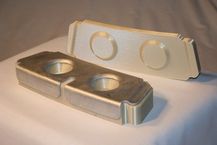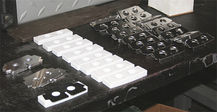- Commercial 3D printers & additive manufacturing solutions
- Order sample print
Metal Hydroforming with a 3D Printer
Hydroforming and rubber pad pressing use pressure to force sheet metal to take the form of a mold or die.The Metal Hydroforming with a 3D Printer is great for:
- low-volume manufacturing
- prototype and development work
- repair parts
- one-off custom parts
Metal Hydroforming can produce complex curves and shapes as well as small undercuts. They are primarily used for low–volume manufacturing. They can also be utilized effectively for prototype and development work, repair parts, and one–off custom parts. For example, hydroforming and rubber pad pressing are used in the aerospace industry to form sheet metal into airframe or engine components. In the automotive industry, they are used to produce engine cradles, suspension components, radiator and instrument panel support beams and engine components. Military depots produce one–off replacements for the repair of damaged vehicles and aircraft.
Application Outline
Hydroforming and rubber pad pressing dies or form tools are traditionally produced using a variety of materials and methods. Challenges with these methods include shortages of skilled labor, long lead times due to a backlog at the Computer Numerical Control (CNC) machine, high cost of raw materials, and high cost and lead times due to outsourcing. Stratasys 3D Production systems can help to alleviate these problems by producing Fused Deposition Modeling® (FDM) tools. FDM technology is an additive manufacturing process that builds plastic parts layer by layer, using data from CAD files.
FDM tools can help companies move from tool design to production in as little as a week. Many FDM tools can be completed in less than 24 hours with lights–out fabrication. Switching to FDM requires little change to current practices and procedures yet offers significant reductions in the time required to produce good parts. FDM reduces the cost for die production by 50% to 70% and reduces lead time by 60% to 80%. There is virtually no limit to the geometries that can be produced with FDM so it is often possible to implement design improvements in the end product. In fact, 3D Production Systems offer greater cost and lead time advantages with more complex and organically shaped parts when compared to CNC machining.
Stratasys offers several FDM materials for its line of 3D Production Systems that withstand the pressures required for hydroforming including acrylonitrile butadiene styrene (ABS) M30, polycarbonate (PC), and ULTEM 9085. The recommended forming pressure range for these materials is shown in the accompanying table. When dealing with rubber pad pressing, 3.0 inch (76.2 mm) tall FDM dies have been successfully cycled on 1000 ton presses using ULTEM 9085. Materials tested over FDM form blocks include aluminum alloys, stainless steels, titanium and nickel-based super alloys such as Inconel. Sheet thicknesses that have been formed successfully range from 0.016 inch to 0.100 inch (0.41 mm to 2.54 mm). These tools have lasted hundreds of cycles showing little to no signs of wear. In one case, a tool lasted 600 cycles without any problems.
FDM tooling also offers a variety of other benefits. FDM tools are lighter and more ergonomic than traditional tooling, resulting in improved safety for the tool handlers and machine operators. Also, due to the natural porosity and lubricity of FDM, the number of cycles required to form trapped pockets can be greatly reduced and the need to lubricate sheet metal blanks can be eliminated. Further, the all digital process supports repeatable tool creation without need for an outside supplier and coordination of secondary tooling such as drill tools, trim tools and check fixtures. This makes it possible to potentially free up valuable storage space.
Stratasys Customer Story
Pryer Technology Group (PTG) is a supplier of hydroforming presses. PTG’s Triform Hydroform Presses incorporate a unique pressure containment system that significantly reduces the press size without sacrificing integrity or durability. PTG evaluated FDM hydroforming form tools as an alternative to traditional form tools to produce one–off components to replace damaged or corroded sections of an aircraft frame. The corroded frame was digitally scanned and a CAD model of the repaired part and desired tool stream was created. A family of the tools including form tool, trim tool and drill tool were then manufactured with the Stratasys Fortus production system. In working with PTG on a variety of form tools, it has been demonstrated that FDM tools can see up to a 70% cost savings and as much as 80% cycle time savings compared to outsourced metal CNC tool fabrication.
“We were not familiar with FDM or the thermoplastic materials that are used in the process,” said Scott Pryer, President of PTG. “But after using FDM tools in our hydro forming presses, we are quite impressed. The FDM dies were produced in hours as opposed to the days that are normally required. These tools withstood up to 10,000 psi of pressure time after time. We believe that FDM tooling is a good option when time or traditional tooling methods are not practical. Since the tool building time–frame is greatly reduced, it will make part development easier. Tool designs can be tested, modified and retested quickly and easily.”
“Along with building the form tool, FDM has proved its value in making other accessories used in our process such as trim tools, drill tools, forming aids, etc,” Pryer added. “When forming down into blind recesses we typically have to use a vent hole to allow trapped air to escape. The FDM tooling is constructed in a way that it can vent trapped air without a vent hole. The plastic material also provides a surface lubricity that, in many cases, will eliminate the need for lubricant.”
 Worcester (Head Office) 01905 458 000
Worcester (Head Office) 01905 458 000 3d@stanfordmarsh.co.uk
3d@stanfordmarsh.co.uk














